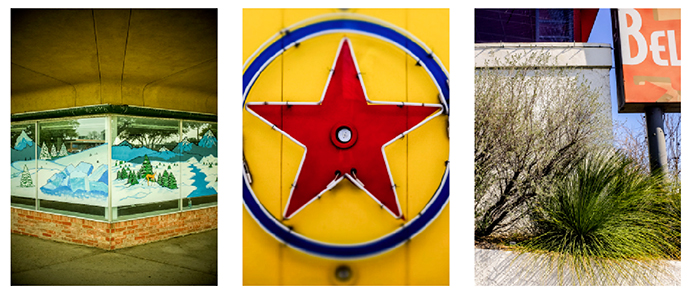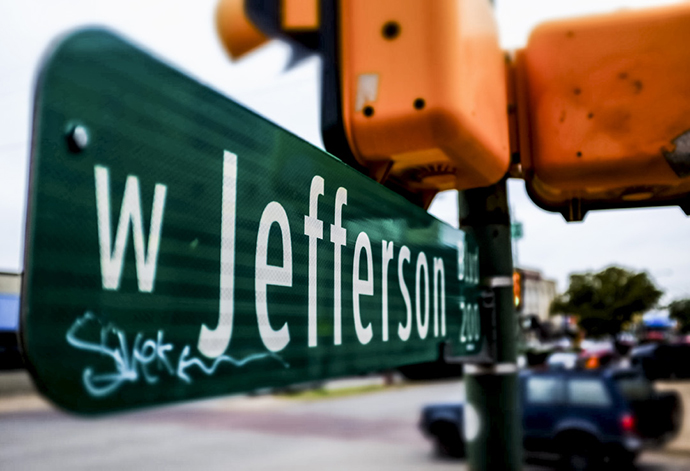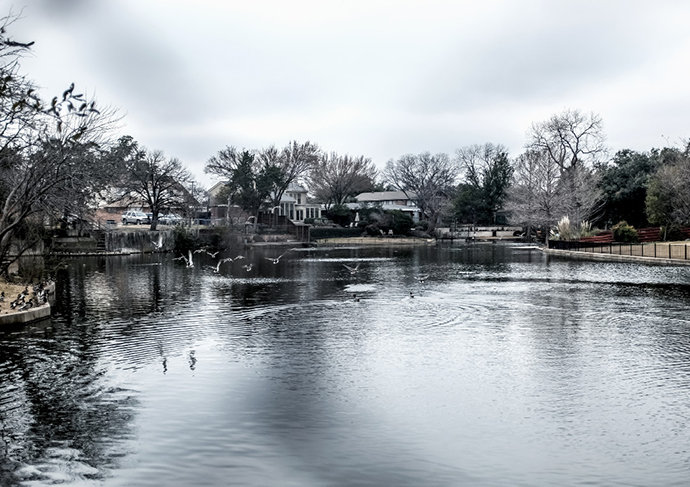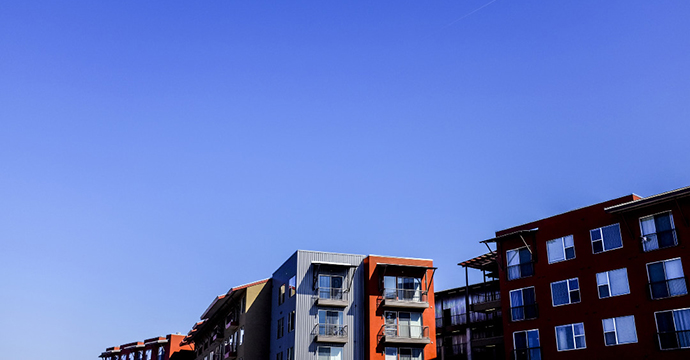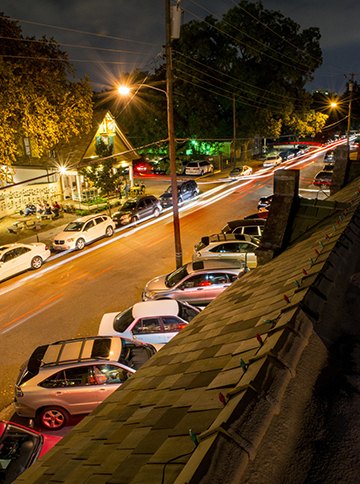The original town of Oak Cliff comprised just about one square mile east of what is now Marsalis and north of what is now Clarendon.
When the suburb of Oak Cliff annexed into the city of Dallas in 1903 with a population around 3,700, it had expanded west as far as Willomet in Winnetka Heights, but was still contained north of Clarendon.
Nowadays the most generous perspective views Oak Cliff as an 87-square-mile section of the city south of the Trinity, from Interstate 30 to the DeSoto city line at Interstate 20, and from Interstate 45 to the Grand Prairie city line past Walton Walker freeway. That’s about a third of the total landmass of Dallas.
The Advocate covers a relatively small portion of that area, about 10 square miles roughly from Interstate 30 to Ledbetter, and from Cockrell Hill Road to Interstate 35. That’s the area some have taken to calling “North Oak Cliff,” which is controversial, but more on that later.
The physical boundaries of Oak Cliff are debatable, but you know you’re here when you’re home.
Original Oak Cliff
Farmers began settling the areas now known as Oak Cliff as early as the 1830s, when this was the Republic of Texas. William Henry Hord arrived from Tennessee in 1845 with his wife and family and three slaves and settled 640 acres just south of the Trinity River on Cedar Creek. This settlement, which became known as Hord’s Ridge, had homes, a gristmill, a boardinghouse and a tavern.
When Thomas Marsalis bought Hord’s land and adjacent acreage in 1887, he renamed it, as real estate developers will do. Since the oak-tree-shaded land was situated above the Trinity, he branded it Oak Cliff and began marketing it as a resort destination. Marsalis eventually went broke, but he invested hundreds of thousands of dollars of his own money into infrastructure, including roads and plumbing. Oak Cliff incorporated as a town in 1890 with about 2,500 residents.
[quote align=”right” color=”000000”]Oak Cliff is more than the name of the neighborhood; it’s part of who we are.[/quote]Marsalis and partner John S. Armstrong started the Dallas Land and Loan Co. and began parceling out residential lots in Oak Cliff, including the Ruthmeade Place neighborhood, just south of 12th. Marsalis also developed the park now known as the Dallas Zoo and surrounding neighborhoods, which are part of the original Oak Cliff.
Around the turn of the 20th century, Oak Cliff’s central business district surrounded the retail buildings, some of which are still standing, at Jefferson and Beckley.
Homes in Winnetka Heights began going up around 1910, and at the time, that often was referred to as “west Oak Cliff.” The first homes in Kessler Park came along in 1923. Purists roughly consider this — the Lake Cliff Park area, the zoo area, Winnetka Heights, Kessler Park, Kidd Springs and everything in between — to be the neighborhood called “Oak Cliff.”
If you live south of Clarendon, west of Hampton or east of the zoo, you’re just appropriating the Oak Cliff name, they say. Call it “South Oak Cliff,” call it “East” or “West” Oak Cliff, call it Red Bird or Wynnewood or Highland Hills or Lisbon. But don’t call it just “Oak Cliff.”
That’s a highly offensive position to take in a neighborhood that so fiercely identifies with its brand. Oak Cliff is more than the name of the neighborhood; it’s part of who we are.
South Oak Cliff
The farming communities of Lisbon and Glendale, east of what is now Interstate 35, were annexed into Dallas in the early 20th century. In those areas of what is now Oak Cliff, farmers started selling off their land for housing developments in the 1910s and ’20s. A retail center at Ann Arbor and Lancaster Avenue became a central business district in the 1920s.
In 1912, G.G. Woodin of Chicago bought acreage between Oak Cliff and the village of Lisbon. Woodin named the development Trinity Heights, and he named all of the streets after states. Trinity Heights, roughly bordered by Ledbetter, the Santa Fe Railroad and the Veterans Administration hospital had about 25,000 residents by 1945. By the 1950s, the name Trinity Heights began to fade as real estate agents began lumping together all the developments and villages south of the original Oak Cliff as “South Oak Cliff”
[quote align=”right” color=”000000”]“The west side of Oak Cliff is flourishing in a way that is not happening on the east side of I-35.”[/quote]Development began in the Wynnewood area in the 1940s. And South Oak Cliff High School was built in the 1950s.
David Kyle went to South Oak Cliff High School in the ’60s. He grew up in a neighborhood that he describes, depending on to whom he is speaking, as “Oak Cliff,” “behind the V.A. hospital,” or “Lisbon.”
He now lives in Kiestwood and still considers the neighborhood “Oak Cliff,” with no modifiers.
South Oak Cliff High School was among the first schools in Dallas to integrate in the 1960s, and Kyle says he remembers the “blockbuster” era of white families selling their homes to black families, sometimes moving in the middle of the night so they wouldn’t have to confront their neighbors. Bigotry toward an influx of African-American neighbors resulted in white families moving out of Oak Cliff and to the suburbs in droves.
Under the old system of at-large City Council seats — members didn’t exclusively represent single districts until the 1990s — South Dallas and South Oak Cliff lacked political leadership. Few in power pulled for those neighborhoods, and for decades they were neglected.
“The west side of Oak Cliff is flourishing in a way that is not happening on the east side of I-35,” Kyle says.
High crime and low economic success on the east side of I-35 made it important to those on the west side to distinguish between Oak Cliff and South Oak Cliff, constructing a definition of “south” that was more than geographical. Much like the South Bronx is defined more by demographics than geography, describing a neighborhood as “South Oak Cliff” sometimes can serve as code to indicate that it is in the “bad part” of Oak Cliff, rather than where it is on the map.
North Oak Cliff
When lifelong Oak Cliff resident Jim Dolan tells acquaintances that he lives in Kessler, “they go, ‘Oh, so you live in the good part of Oak Cliff,’ ” he says.
Dolan grew up in Winnetka Heights — although he didn’t know it was called that at the time — and graduated from Bishop Dunne Catholic School in 1969.
His family moved into some apartments near Hampton and Ledbetter when he was in high school.
“It was a clean, modern, very suburban kind of community back in those days; very similar to late-’50s, mid-‘60s neighborhoods you would find in Richardson or Lake Highlands,” he says. “It was not mixed-race, which now I believe it is majority black.”
That area sometimes is referred to these days as South Oak Cliff or, being more accurate geographically, Southwest Oak Cliff.
In the ’60s and ’70s, Dolan says, there was no such distinction.
“We just called it ‘Oak Cliff’ and didn’t think much about it,” he says.
Using the term “North Oak Cliff” might be convenient when searching for real estate listings, but in conversation, it is an easy way to annoy the heck out of neighbors south of Clarendon.
[quote align=”right” color=”000000”]“If you say Oak Cliff is just North Oak Cliff, you’re wrong and you’re missing a lot.”[/quote]On the outskirts of the city, when you’re closer to Duncanville than to downtown Dallas, the Oak Cliff identity can become a little weaker.
But neighbors in Elmwood, Oak Park Estates and the neighborhoods surrounding Kiest Park and Kimball High School firmly identify as Oak Cliff.
“We are trying to encourage everyone to say ‘Oak Cliff,’ ” says Old Oak Cliff Conservation League president Lisa Benskin.
That’s an inclusive attitude, and the league is working to add as many member neighborhoods in Oak Cliff as possible, including those east of I-35.
Judy Brooks grew up in Lake Highlands, but her husband graduated from South Oak Cliff High School in the ’60s, and they have lived in his grandparents’ former home near Kiest Park for over 10 years.
Hearing the word “north” precede “Oak Cliff” is something she’s grown accustomed to, but it makes her feel left out.
“If you say Oak Cliff is just North Oak Cliff, you’re wrong and you’re missing a lot,” she says.
The Oak Cliff Chamber of Commerce, located on North Bishop, sets no definitive geographical boundaries.
“People can be very offended if they feel they’re being excluded,” chamber president Kiyundra Gulley says. “Wherever you think Oak Cliff is, that’s where we say it is, too.”
West Dallas
When Monte Anderson renovated the Belmont Hotel 10 years ago, he drew upon the success of the Bishop Arts District, going so far as to provide a shuttle service from Bishop Arts to the Belmont.
“We couldn’t have done that without the success of Bishop Arts,” he says.
Now construction on thousands of new apartments is going like gangbusters in West Dallas. Trinity Groves is drawing Dallasites over the Margaret Hunt Hill Bridge to drink and eat high-dollar meals in a neighborhood that for more than a century has been among the poorest and most neglected in Dallas.
At the turn of the 20th century, West Dallas was home to immigrants and itinerant workers; some lived in shotgun shacks and others lived in camps along the river.
[quote align=”right” color=”000000”]“Interstate 30 could’ve been like the Berlin Wall in the 1960s. No one wanted to claim West Dallas then.”[/quote]When the family of West Dallas’ most notorious son, Clyde Barrow, moved there in the 1910s, they camped with their wagon on Muncie Avenue until they could build a house.
The town’s reputation for crime and shady activity was so bad that residents voted in the 1930s to change the name of its notorious main street, Eagle Ford Road, to Singleton in hopes of improving its image. The town of West Dallas wasn’t annexed into the city of Dallas until 1954.
And now, over the course of a few years, West Dallas has become the darling of real estate developers, a hotspot for hip Highland Parkers.
It’s great that some money and attention are being spent on West Dallas, but please, please don’t call it Oak Cliff, says Jeff Herrington, who lives in Kessler Park but was a founder of the Fort Worth Avenue Development Group and serves on the board of the West Dallas Chamber of Commerce.
“Interstate 30 could’ve been like the Berlin Wall in the 1960s,” he says. “No one wanted to claim West Dallas then.”
There are some who say West Dallas begins not at I-30 but at the railroad tracks, which have been there longer.
But members of the Baby Boomer generation of Oak Cliff generally agree that all of Fort Worth Avenue was considered West Dallas.
The Trinity River levees were built mostly on the labor of immigrants living in West Dallas. West Dallas lead-smelting plants, which opened in the 1930s, poisoned the air and soil, and it would be decades before any action was taken to clean up extremely high levels of lead. The sites of the smelters were federal superfund sites from 1993-2005.
West Dallas survived all that, and now it seems we’re coming for its identity. “The people who have lived there for years, they’re very proud of their community, and it irritates them that people suddenly want to call it Oak Cliff,” Herrington says.
Where is the Bishop Arts District?
Northern Dallasites and suburb dwellers know exactly where the Bishop Arts District is. It’s Emporium Pies and Hattie’s and Tillman’s Roadhouse.
Those really in the know might also point to Bolsa and Spinster Records and the Kessler Theater as favorite Bishop Arts District spots. If that perspective makes you cringe, then you must be from Oak Cliff.
The boundaries of Bishop Arts are set very specifically in the 1992 Dallas City Ordinance that established the area as a conservation district. The official boundaries are Seventh Street, Melba, Llewellyn and Zang.
But to many outside the neighborhood, Bishop Arts is Oak Cliff, and Oak Cliff is Bishop Arts. To them, anything cool in northern Oak Cliff can be called Bishop Arts.
Business owners and real estate developers are making efforts to brand some of the areas surrounding Bishop Arts with their own identities. But why use a different name when the Bishop Arts District already is a successful neighborhood brand?
“Yes, let’s obsess over something that people north of the river don’t care about,” says David Spence of Good Space.
Good Space redeveloped the building that houses Spinster Records and several other shops at Tyler and Davis.
Originally, Spence called it the Clinkinbeard Campus after the family that built the 1930s retail strip, but “Clinkinbeard” doesn’t exactly roll off the tongue. More recently, he commissioned an enormous temporary mural inside the corner space, which is visible from West Davis, reading “Ty/Po.” That’s for Tyler/Polk. Spence thinks that once Polk and Tyler are changed to two-way streets, retail and restaurants along the corridor could become a destination.
If so, why not call it Ty/Po? That’s certainly memorable.
“We’re not presuming or trying to foist that name on anybody else,” Spence says. “We are launching that with a sense of humor and with no expectation that it’s going to go anywhere beyond our campus.”
Various efforts have been made to rebrand the Tyler/Davis area, including the Tyler Davis Arts District and X+, but none really has stuck.
Jeffrey Liles of the Kessler Theater is behind X+, which he named for the “X” formed where Kings Highway crosses Davis and “+” or “plus,” where Tyler and Polk cross Davis.
When people north of the river come into Oak Cliff via Sylvan and Tyler, they can turn left at West Davis for Bishop Arts, or they can turn right for the Kessler.
That’s why Liles thought the Kessler’s neighborhood needed its own brand. If the one-half mile between Bishop Arts and the Kessler were walkable, the story might be different.
“The Bishop Arts District is essential to what makes Oak Cliff great, but there aren’t sidewalks between here and there,” he says.
Liles, a talent buyer and musician who has been on the Dallas music scene since the ’80s, also hoped that X+ would become a new shorthand for the live music scene in Dallas. For decades, musicians knew Deep Ellum meant live music, and Liles wants X+ to mean the same.
The X+ brand is a way to express that online as well.
Since before the Kessler opened five years ago, Liles and the theater’s staff have been posting videos of live performances on two YouTube channels, and they all have “Kessler X+” in their titles. It’s a search term that makes it easy for music industry people in New York, Los Angeles and Nashville to see and hear what the Kessler offers.
“X+ isn’t meant to be a real estate thing,” Liles says. “I want the artists who play in Oak Cliff to have a platform that gives them an identity and protects their creativity and protects their artistic statement.”
Appropriating the brand
The Bishop Arts name is used as far from the district’s center as Rosemont at West Davis, where an apartment complex recently was renamed Bell Bishop Arts. And the Bishop Arts Winery is right at the corner of Tyler and Davis.
The Nazerian family’s $42 million development between the Bishop Arts District and Jefferson Boulevard is called Bishop Arts Village. New development could spring up on the corners of Zang and Davis, especially with a planned streetcar stop there.
All those things could expand even what Oak Cliffers consider to be Bishop Arts.
Jim Lake Jr., whose family company began redeveloping Bishop Arts storefronts in the 1980s, says the true Bishop Arts District is strictly within the boundaries of its conservation district.
“I guess we should be flattered” that the name is being used outside the geographic boundaries, Lake says.
Lake is also behind the revamp of Jefferson Tower, where upstarts Small Brewpub, Carnival Barker’s ice cream and Cultivar coffee are going in alongside legacy Oak Cliff businesses Gonzalez restaurant and Ramon’s barbershop.
The tower, which also has a residential component, already draws some of the same customers as Bishop Arts, but it’s something else, Lake says.
“We want to brand that with its own identity,” Lake says. “I view Jefferson as a totally different district that will be adjacent to Bishop Arts.”

